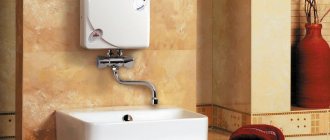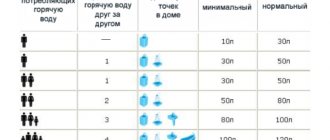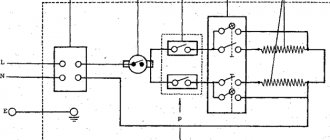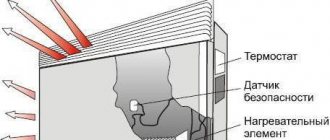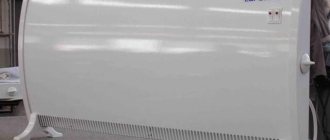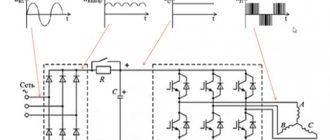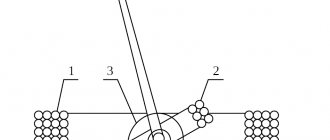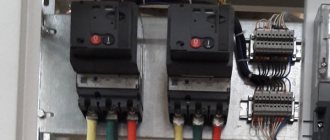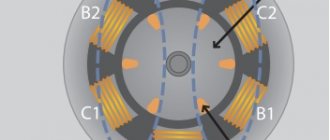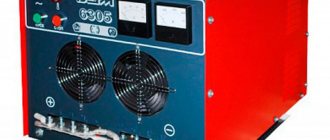0
6309
14.12.2015
The problem of lack of hot water supply is quite widespread in most of our cities. Even where it exists in principle, there are periods when there is simply no hot water in the tap. A storage water heater is an acceptable solution to this problem. There are other types of water heating equipment, but in this article we will look at storage water heaters: the operating principle of these devices, features of operation, maintenance and repair. These devices can be powered by burning gas, electricity and even solar energy, the main thing is that they meet the requirements for this type of household appliance.
Boiler design
In this diagram you can see the main elements of the boiler design.
A boiler is a device that heats and stores hot water. Structurally, it is a container of one volume or another, equipped with thermal insulation and a heating element. The water supplied to the tank is heated to a predetermined temperature, after which it can be used by consumers. The heating temperature is adjusted and maintained using a built-in thermostat. The maximum temperature reaches +70-80 degrees. Most boilers have a pressure design. That is, the outlet water flows under the same pressure under which it is supplied to the unit’s tank. If the supply of cold water stops, then it will not be possible to get water from the storage water heater - it simply will not flow out of it. Thus, the water in the tank is under constant pressure (increasing with heating).
How does a boiler work and what components will we find in its interior?
- A tank with a protective coating is the basis of any storage water heater. Tanks are made of metal and coated with enamel or glass-ceramics to prevent corrosion. Tank capacity varies from 10 to 300 liters;
- Heating element – inside boilers we can find one or two heating elements. They are responsible for heating the water (in gas boilers this function is performed by the burner);
- Thermostat – provides support for the set temperature (mechanical or electronic adjustment is used);
- The control panel is hidden or open, it is used to set the temperature;
- Thermometer – provides control of the temperature of the water in the tank. The thermometer can be mechanical or electronic.
The design of boilers is extremely simple, and the main volume is occupied by massive tanks of varying capacities.
Rules for operating the water heater
Since electric water heating devices are much more widespread, we will look at them in more detail. It is clear that any equipment needs to be treated with care. Storage water heaters are no exception. The principle of operation of this device is such that you should not force it to work at full capacity all the time. This can lead to a fairly quick failure of the heating elements, or the activation of a protective relay, which will have to be called in by a technician to turn it on. The optimal sufficient temperature is 60 degrees. To achieve it you need to use all the heating elements. This does not greatly increase energy consumption, but it makes their wear more even.
Most models turn off automatically when they heat up to 85%, and will turn on only after it has cooled down a little, if the protection does not work. At night there is a reduced tariff for the use of electricity, which allows you to save money by choosing the optimal heating mode. After all, during the day the device can be turned off. All the same, the water in it will not cool down until the evening. Heating water at night will cost twice as much. Some modern models are already equipped with an economical heating function. Its essence is that the water is heated at night, and during the day its temperature is only maintained at the minimum acceptable level - i.e. 55 degrees.
Scheme for connecting a storage water heater to an indoor water supply system
For the operation of the device to be completely safe, several simple elements are required: firstly, conventional grounding. Secondly, a protective reducer, which is needed to compensate for increased pressure in the water supply network. Thirdly, a safety valve that protects the water heater from too high pressure inside. It simply drains the water if necessary. Fourthly, a check valve that blocks the exit of water from the tank if its supply suddenly stops - this is necessary so that the heating elements do not fail. The last three listed items are named and do not necessarily come with the main device. They often need to be purchased separately. It happens that some manufacturers assemble all three components into one unit, which allows for more convenient installation. The speed of heating water in the device directly depends on the power of the device itself, as well as the level of electrical energy consumption.
How to choose a storage water heater depending on the number of family members
If you use water from a storage water heater, then consider the following important points:
- If the water in the tank stagnates, it should never be used for food. This is especially dangerous when the water temperature has dropped to a level where various pathogenic bacteria could arise and begin to multiply.
- If your storage water heating device is installed outside the city, and you use ordinary water from a well, then at least once a month you need to heat the water to the maximum temperature for the purpose of disinfection and prevention.
- The condition of the inner surface of the tank is very important. If you have sufficient finances, it is better to choose a model that has a special coating, for example, glass porcelain. It will ensure the purity of the water in the tank, regardless of the time it remains there.
- If you are leaving for a long time and the storage water heater will not be used for some time, the water must be drained. This is especially important if you are leaving for the whole winter. After all, freezing the water inside the tank will not lead to anything good. This will simply disable the device completely and it will no longer be subject to repair.
Pros and cons of boilers
Using a boiler, you can heat a large volume of water.
In the absence of a centralized hot water supply system, boilers are used. Their advantages include the following:
- Ease of use.
- Large volume can be heated.
- One device can be used to supply several rooms.
- The operation of the device does not depend on the pressure force.
- Possibility of heating to high temperatures.
- Maintaining high temperatures for a long time thanks to high-quality thermal insulation of the tank.
A large boiler requires a lot of space.
The disadvantages include the following:
- Long time for initial heating.
- If water flow is low, maintaining a constant temperature will incur energy costs.
- A large tank requires sufficient territory.
- The cost is higher than that of a flow-through product.
If there are problems with the water supply, you can install a boiler in an apartment building. The design and principle of operation will depend on the type of device, its functionality and additional functions.
Electric water heater device
Plumbing Electrical circuit of a water heater Hot water supply provides comfortable living conditions for a modern person. Installation of water heaters must be carried out in accordance with the markings indicated on the body of the water heater: Marking.
Here the difference is noticeable; for flow-through ones the price is rubles. Economical: in addition to heating the water itself, electricity is spent to compensate for heat loss through the insulation layer of the tank.
Familiarize yourself with the existing nuances to get the job done as efficiently as possible. The connection is made from the thermostat output terminals.
This is done due to the small diameter of the fitting, to which only a rubber hose with a small cross-section can be attached.
At this moment, the transistor VT1 opens and the control electrode of the power thyristor VS1 is shunted to the minus of the circuit, from which it was previously separated by a voltage drop across the resistance of resistor R4. This chain is configured so that with a current through the primary winding of 30A, a voltage of 45 volts is generated on the capacitor. The RCD and the automatic circuit breaker perform protective functions: the RCD eliminates the possibility of electric shock in the event of a leak, when the insulation is damaged or a breakdown occurs in the housing; Using a circuit breaker, the network is protected from overloads and short circuits.
The PE neutral protective conductor is connected to the tank body using a special screw. 21 Hot water recirculation scheme
We recommend: Energy efficiency analysis of buildings
Device depending on type
Direct heating
The energy that enters such devices is spent only on heating the water inside the device. This means that these types of devices themselves produce heat, which warms the water. They can be gas, when a gas burner is used for heating, as well as electric, that is, heated by a heating element.
By design, such boilers are a container (tank of water), around which there is thermal insulation and an outer casing with a control panel. In addition to the heating element (burner or heating element), such devices have a magnesium anode, a thermostat, a safety group and pipes (input and output).
Indirect heating
This type of boiler is installed in houses or apartments with autonomous water heating, which includes a single-circuit boiler. The temperature of the water inside a boiler with an indirect heating type increases not due to the direct influence of the energy source, but as a result of heat exchange with the heating circuit.
The design of this type of boiler includes a housing, inside of which is placed an internal tank, separated from the outer casing by a layer of thermal insulation. Water from the cold water supply pipes enters the tank through the inlet pipe, and is discharged after opening the hot water tap through a pipe located at the top of the device.
Separately, the device has a heat exchanger, which in most models is represented by a coil. It can be evenly spaced inside the tank or located in its lower part. Both pipes of such a heat exchanger are connected to the heating boiler.
The coolant from the boiler moves through the heat exchanger, heating the water in the tank through heat transfer, and then is discharged through a separate pipe, returning to the boiler. There is usually only one such heat exchanger, but there are models with several heat exchangers that can be connected not only to a gas boiler, but also to another source.
There are also indirect heating boilers without a coil, the design of which is called “tank in tank” due to the presence of another tank inside the tank of such a boiler. Sanitary water in such a device is heated in an internal tank, and the coolant moves between the walls of the internal tank and the outer walls.
Some models of boilers of this type may have a recirculation pipe. Mandatory elements of all such devices are a magnesium anode and a safety group, as well as a temperature sensor. Large boilers with a capacity of over 150 liters often have an inspection window.
Combined
Such boilers combine the two previous types of heating devices. By their design, they are represented by devices with indirect heating, but differ in the additional installation of a heating element, which allows the device to be used as a directly heated storage electric boiler. This is especially in demand in the summer, when the single-circuit boiler is turned off.
4b1fd3f2b51f6fc7e5262e23a4c4c72b.jpeWhere can I buy
You can purchase water heating equipment as quickly as possible at your nearest specialized store. The optimal option, in terms of price-quality ratio, remains purchasing from the AliExpress online store. Mandatory long waits for parcels from China are a thing of the past, because now many goods are in intermediate warehouses in destination countries: for example, when ordering, you can select the “Delivery from the Russian Federation” option:
| Photoelectric water heater, 220-240 V, 3000 W | TINTON LIFE multi-tap electric water heater with tap, LED display | Electric water heater, touch HYUNDAI |
| Instant water heater 3000W | 8L Stainless Steel Tankless Water Heater | FRUD Instant Heating Electric Faucet |
Almost like a thermos
In a thermos, the flask has a double glass flask with a vacuum - a heat insulator. In a boiler, the water tank is made to withstand metal corrosion and work under pressure. The best material is stainless steel. But such a tank turns out to be the most expensive, even in comparison with a structure made of ordinary steel coated with a super-anti-corrosion compound. The heat insulator is any modern material with the necessary properties, placed between the internal and external parts. If water flows from the inner tank through its corroded wall, the outer part will not save you from the flood.
Corrosion as it is
Therefore, for storage water heaters, corrosion protection is the most important task. It is solved by placing a special rod with a layer of magnesium inside near the heating element. It is called a magnesium anode and is designed to protect the housing from corrosion. Magnesium is chemically more active than iron in the body material. For this reason, negative ions in the water interact with this anode, and not with the wall, which may have a microcrack in the protective layer. The anode is a consumable item that is recommended to be replaced annually.
In a direct heating boiler, the heating element can heat water to temperatures even above 100 degrees Celsius. At the same time, due to the increase in pressure, it will not boil inside the tank. This is fundamentally dangerous for users. The water will boil immediately when it comes out of the tap, and splashes of boiling water will scatter in all directions. Therefore, a reliable automatic thermostat with a thermometer and thermostat is required in the boiler. The factory setting of the thermostat operation will eliminate the human factor, ensuring timely shutdown of the heating element in any case.
Tank Features
The most modern storage water heaters have a tank made of stabilized and high-strength steel alloys, which are characterized by resistance to corrosive changes.
The inner surface is covered with a layer of glass porcelain, which is subjected to high-temperature firing. The porcelain glass coating is chemically neutral and corrosion-resistant.
Storage water heater design for vertical installation
The special crystalline structure of the porcelain glass tank can withstand even very high deforming loads . The internal tank is protected by a magnesium anode, which effectively prevents electrochemical corrosion processes.
Periodic replacement of such an element has a positive effect on the service life of the water heating device.
Gas heaters
- A storage gas boiler uses a gas burner as a heating element. The power and heating speed of a gas water heater are higher. But to install a gas storage boiler, you need equipment for exhaust gas removal.
The design of the gas storage water heater also includes a control device. The photo shows that in appearance, only the presence of forced gas removal distinguishes electric and gas storage boilers.
Storage-type boilers also require the installation of special safety fittings, which include a check valve, a safety valve and a reducer.
The video below shows different types of storage boilers and examples of their installation.
- Flow-through gas boilers are also called geysers. The principle of operation is the same, the difference is in the design and method of ignition. In appearance, a gas water heater is a metal box, to which two pipes fit, one with water, the other with gas. Main parts of the structure:
- heat exchanger;
- main burner;
- pilot burner.
The gas released during combustion of the main burner is sufficient to heat water in a heat exchanger made in the form of a spiral. Modern models of geysers use electronic ignition.
Forced or natural exhaust gas removal is also necessary
When using geysers as hot water equipment, special attention must be paid to good ventilation of the room
Indirect heater
An indirect water heating boiler uses heat generated, for example, by a home heating system. The main convenience is the use of water from the heater at several points in the house, since the device has a supply of hot water in the tank. Externally, the indirect water heater is also cylindrical in shape, but rectangular options are also possible.
The design consists of a tank, inside of which a heat exchanger is placed with coolant circulating through it. Inside there is a magnesium anode designed to prevent corrosion of the internal surface of the boiler. The anode is part of a safety system group that also includes a check valve, an overpressure valve and a temperature sensor.
It is advantageous to purchase an indirect heating water heater together with a single-circuit heating boiler. Although together this unit costs more than a double-circuit boiler and is a more bulky structure, it provides an almost uninterrupted supply of hot water to several points, with a uniform temperature of the supplied water.
Models of vertical and horizontal installation boilers are available, which are installed depending on the area of the room; vertical ones are attached to the wall and take up less space. Models without heat exchangers consist of containers inserted into one another, with coolant circulating between them. A combination boiler option is possible, in which water is heated both from an external source and from a heating element.
Modern water heaters are equipped with thermostats that ensure safe operation of the device. Replenishment of water used from the water heater occurs automatically. The reliability and durability of the boiler also depends on the internal coating of the tank, which today is mainly made of glass porcelain and enamel. The heating time of water in a water heater depends on the power of the heating element. The power of gas boilers is twice that of electric ones.
There are also non-pressure open boilers, although they provide hot water to one point, they are applicable in systems with little or no water pressure.
Summarizing all of the above, it should be noted that the operating principle of all modern boilers is simple, which makes them indispensable for rooms in which there is no centralized supply of hot water.
Heating elements and magnesium anode
One of the main structural elements of water heating equipment is a steel flange used to fix a thermo-electric heater in the form of a nichrome spiral in a copper casing, as well as a magnesium sacrificial anode and thermostat.
A feature of the removable type support flange is that it is secured to the equipment body using a conventional threaded or bolted connection.
Magnesium anode
How to save energy?
You can save a little on the electricity that the boiler consumes during operation. For this it is recommended:
- Set the heating temperature not to the maximum (75-85 degrees), but to 55-60. When cold water enters the tank and combines with the liquid that is already there, less energy will be needed to heat the mixed mass. In addition, a temperature regime of 55-60 degrees will help to significantly reduce the process of scale formation on the heater.
- It is necessary to choose the correct location of the boiler so that the pipeline from it to the sink or shower is not too long. Due to this, the heat from hot water will dissipate less.
- Periodically it is necessary to carry out preventive cleaning of the heating element from scale. Due to this procedure, its operating efficiency increases - the energy costs for heat generation will be less.
22e65a3b7f400f308f4218b9c699320a.html
What is a boiler, its purpose
A boiler is a device for heating water, fully automated. It has different shapes, round, square, flat or elongated. It can be mounted both vertically and horizontally (certain models). Boilers differ in heating method, mounting features and volume. Also by type of coating: glass porcelain, enamel, titanium enamel, stainless steel. Also according to the principle of operation: flow-through and storage. The purpose of the unit is to collect water, heat it, and maintain the desired temperature. It is used both for home (apartment, country house, cottage) and public use (bars, restaurants, saunas, office).
The purpose of such devices is to supply hot water to the user in a completely autonomous mode.
Top 5 popular models
| Model name | Volume of the tank | Price | Power | type of instalation | Peculiarities |
| BOSCH Tronic 1000 T ES 050-5 N 0 WIV-B | 50 l | 125 USD e. | 1.5 kW | vertical, wall | magnesium anode, thermal insulation – 32 mm |
| Ariston ABS VLS PW 80V | 80 l | 270 USD e. | 2.5 kW | vertical, wall | Frost protection, thermal insulation – 32 mm |
| GORENJE GBF 80 | 80 l | 190 USD e. | 2.0 kW | vertical, wall | magnesium anode, thermal insulation – 17 mm |
| THERMEX IF 100 V | 100 l | 245 USD e. | 2.0 kW | vertical, wall | magnesium anode, thermal insulation – 17 mm |
| THERMEX ER 80 V SilverHeat | 80 l | 100 USD e. | 1.5 kW | vertical, wall | magnesium anode, thermal insulation – 17 mm |
Flow or storage?
As mentioned above, of all the differences between water heaters, there are these two important parameters. Let's look at them. Storage devices have a number of advantages, as well as disadvantages. It all depends on the scope and possibilities of their use. The first advantage of such devices is volume. If a large consumption of H2O is envisaged, then the storage units have a reserve (certain models) of more than 200 liters. The second plus is the presence of an anode, which allows you to soften the water, and thereby extend the life of the equipment and individual modules. Another plus is that such devices operate under pressure, which allows you to power an entire system of branches and plumbing points.
Now to the cons. The biggest one is size. Although there are heaters of different shapes and mounting methods on sale, when choosing such an electric water heater, you need to take into account that it will take up a lot of space. Also, storage heaters (due to their volume) take longer to heat up compared to flow-through heaters.
In addition to traditional, round or square vertical units, there are also flat ones that can be mounted horizontally. These devices are more compact due to their shape. This was achieved by reducing the diameter of the container, but adding another one. That is, inside such a device there are two cylinders connected to each other. There are also flat water heaters that support two mounting methods, vertical and horizontal. This greatly facilitates their location, but one detail should be taken into account: such a device can be rotated 90% only in a certain direction. This is due to the difference in the location of the heating element and the outlet pipe. Therefore, when purchasing such a device, you should accurately calculate in which direction it will be turned, and be sure to check with your sales representative about the mounting features.
Connection diagram and installation
The storage water heater should be installed in strict accordance with the installation instructions, which you will definitely find in the user manual.
We want to give you several recommendations that will allow you to connect the device to communications as efficiently and safely as possible.
- The boiler should be installed against a wall; at the same time, make sure that the pipes for hot and cold water are strictly parallel to it. There should be a small distance between the water heater and the wall, allowing for preventive inspection and maintenance of node connections.
- It is recommended to use a ¾-inch diameter pipe to connect to the water supply. Stand facing the appliance: the hot water pipe should be located on your left hand, and the cold water pipe should be on your right hand.
- Using a safety valve for storage water heaters will help avoid overheating of the device and associated unpleasant consequences.
- Before you start connecting the boiler to the water pipes, open the cold water tap. Make sure it is clean enough to be free of sand, rust particles and other small debris. If necessary, cut a special water filter into the pipe (in the section of the network before the water heater).
- It is also recommended to check the pressure in the water pipes before starting installation. Its level should not be higher than 8 bar. If this figure is exceeded, a pressure reducer should be installed.
- Drops of water falling from the hydraulic valve are a sign of normal operation of the device and the water supply network. But it is necessary to ensure that water from the valve does not fall on the body of the water heater. To do this, you need to attach a special drain funnel to the valve with an outlet into the sewer.
- If the boiler is installed in a country house that does not have constant heating, you need to make sure that there is no water left in the tank when the outside temperature drops below zero. Therefore, when leaving the house in the cold season, always drain the remaining liquid from the tank, otherwise the device may fail.
Advantages and disadvantages of water heaters
Above we talked about how an electric storage water heater works. Many of you can say that the cost of an 80L electric storage water heater is very high. But the price can be offset by its most important advantage - saving money. This happens if, when using a boiler, you simply do not pay for hot water. Moreover, this is of great relevance for those people who have meters installed in their house or apartment. In this case, only cold water and electricity are consumed. As for the latter, in minimal quantities.
- Different models of water heating devices may have different features. Horizontal flat storage water heaters of 80 liters have the following advantages:
- Compact sizes. A flat boiler will take up several times less space than a round one. You can easily install it on the floor, on the wall in the kitchen or anywhere else. The flat model of the heater is an excellent rhenium for an apartment with a small area.
- Maintaining water temperature. In addition to all the advantages, the flat, round storage type heater has a Thermos function. This means that the water cools slowly. It follows that you do not need to heat the water every time you need to wash dishes or take a shower.
- The plant issues a two-year warranty for each water heating device. Based on this, in the event of a breakdown, you have the right to contact a service center for repairs completely free of charge.
If we talk about the disadvantages of flat boilers, then a lot will of course depend on the model. For example, if the heater is a flow-through type, then you can forget about saving electricity, since the water will heat up as it moves. This means that heating energy will be used as long as the water is flowing. Storage boilers in this case are much more profitable, for example, you can use heated water just once for a long time without turning off the heating element. Many developers specifically reduce the energy efficiency of flat-plate heaters to reduce their overall size. Based on this, there is no need to buy a very small model; most likely, it will be ineffective.
What to look for when choosing a boiler
Each boiler has certain pros and cons. But there are several points that you simply need to pay attention to when choosing various options for water heaters:
- Mechanical control of the device will always be more reliable than electrical control, since electrics can lead to breakdown of the entire equipment in the event of accidental power surges.
- Enamel coating is the most effective because it can prevent corrosion at the welding site. There is another great advantage of enamel - low electrical conductivity. As a result of this, the enamel-coated tank will not be subject to seam corrosion.
- It is best to determine the volume of the water heater in advance, approximately calculating how much water you expect to use per unit of time. A very small tank will not meet your needs if you have a large family. But at the same time, an 80-liter tank in a house for one person will consume a lot of excess electricity.
- A heating element that does not come into direct contact with water will serve you much longer. This is due to the fact that scale does not begin to form on it. There is another advantage of a dry heating element - it does not drain the water from the tank.
- Any heating device requires constant maintenance, regardless of the frequency of its use. The more often you check the device for breakdowns and replace parts that have failed, the longer the device can serve you.
- If you purchase a boiler second-hand, you will not be given a warranty card and you have great risks of buying low-quality equipment.
- The boiler must be installed by professionals. If you want to install a flat, vertical or other heater for 80 liters, this may lead to its breakdown, and as for the warranty, it will no longer be valid.
It is worth noting that barrel-shaped or flat boiler devices of the same volume will not differ from each other. So, when choosing its shape, you should be guided by the availability of free space in your house. An 80 liter flat vertical storage water heater would be a more suitable option for a small house or apartment.
Popular models and their characteristics
An 80-liter heating device will be the best option for a family of two or three people. The characteristics of boilers and their prices may vary. It depends on the manufacturer. Below in our article we will tell you about the most popular models. In addition to all the above models, there are also a huge number of inexpensive and very reliable 80l boiler models. In this case, the choice will depend on your own preferences in relation to one or another manufacturer and several factors. If you cannot choose the right model yourself, then it is better to seek advice from an experienced specialist.
Boiler care
If a boiler is installed, then you need to learn how to care for it. To extend the service life of a storage water heater, you need to constantly carry out technical inspections and change parts. A very common problem is the appearance of scale on the heating element. This can be completely avoided by installing special water filters on the inlet pipe, or by constantly replacing the heating element.
In addition, problems with the tank can arise if there are a large number of seams on it, which will be problem areas due to the formation of corrosion. This will be relevant for vertical, flat Thermex 80 liter boilers.
Tips for choosing a boiler
Like any household appliance, a boiler has its positive and negative sides.
The most important advantage of this technique is that under any external circumstances there will always be hot water in the house. For small towns and villages where there are problems with hot water supply (or it is completely absent), this is the only way out.
When choosing a water heater, you need to consider the advantages and disadvantages of each of them. For example, by installing a flow-through boiler, you will not have to wait for the hot water to warm up; its quantity will not depend on the volume of the tank. But you will need a powerful hotel machine and a power cable to connect the device, and electricity consumption will also increase significantly.
A storage boiler consumes less electricity, but only produces a certain amount of hot water. And its main drawback is that it takes up a lot of space.
When choosing a boiler, you must adhere to certain criteria.
Purpose of installation
The main criterion when purchasing a water heater is the purpose of its acquisition:
- have a reserve in case of shutdown of hot water supply;
- instant heating of water for washing dishes or taking a shower;
- constant supply of apartments (houses, cottages) with hot water.
External dimensions and volume
You must immediately decide on the installation location of the water heater. The equipment is large and cannot be placed or hung anywhere.
When selecting external parameters, we must not forget about such an important criterion as the volume of the boiler. This value depends on the number of people living in the house
The equipment of the bathroom also plays a certain role, that is, what is used for bathing - a shower or a bath. Using a shower is much more economical; this type of bathing consumes about 15-20 liters of water per person. In the bathroom, for such a procedure you will need 50 liters.
Water consumption table
If a boiler is needed only to provide hot water for washing dishes, and nothing else (without bathing), then a device of 15-20 liters will be sufficient. This type of water heater is usually installed in the kitchen directly under the sink.
Power
An important role in choosing. The more powerful the heating element (from 1 to 6 kW), the faster the water will heat up, but will the electrical wiring in the house withstand such a load? If it is new and capable of withstanding a load of 6 kW, then the power of the boiler can be easily selected based on the needs and number of residents. In apartments with old electrical wiring, the maximum you can count on is a 2.5 kW water heater.
Tank inner lining
In cheap boilers, the internal coating of the tank is made. Expensive models use titanium coating or stainless steel. When choosing, a person proceeds from his financial capabilities, but a high price, as a rule, guarantees quality and durability. In the case of household appliances, there is no need to skimp.
It is recommended to check the quality of the water heater by weight. The heavier it is, the better it will resist corrosion due to the greater wall thickness.
Internal coating of the tank (stainless steel)
What else should you pay attention to?
The degree of protection against moisture and dust of the boiler (IP) must be at least 23. If the water heater is installed in a bathroom, sauna, bathhouse, you will need a more protected model with IP 44. It is worth giving preference to models with a dry tubular electric heater (TEN). )
Lack of contact with water not only prevents the appearance of scale, but also reduces the risk of electric shock, since the heating element is placed in a sealed glass.
When purchasing a boiler, be sure to ensure that it contains a magnesium anode. Models with overheating protection, power-on indication, and accelerated heating function will be safer and more comfortable in terms of operation.
When choosing a boiler for a summer house where no one lives in winter, you should give preference to models with a freeze prevention mode.
When purchasing a water heater, be sure to inquire about its thermal insulation layer
The recommended thickness is at least 35 mm (the thicker, the longer the temperature will be maintained). The highest quality material is polyurethane foam (much better than foam rubber).
About instantaneous water heaters
Unlike storage boilers, the principle of operation of a flow-through water heater is to quickly heat running water as needed, rather than in advance.
The heat sources are the same electric heating elements and gas burners, only they turn on after the hot water tap in the house opens. Such heaters include:
- geysers;
- flow electric heaters.
Note. Sometimes, to provide hot water supply to a private home, a plate boiler is used, which is a water-to-water heat exchanger. Like an indirect heating boiler, it transfers the energy of the coolant to water, only it does this in flow mode.
The design of the geyser is quite complex, and therefore deserves a separate topic. An electric water heater is simple: a powerful heating element heats running water in it. Having such an advantage as its small size, the device has too high power consumption and therefore its scope of application is limited. The design of a flow-through electric boiler is shown in the figure:
The advantage of instantaneous water heating devices is that they can supply heated water without preparation and for an unlimited time. But its consumption has limits, which is important when there are a large number of consumers.
Purpose and operating principle of an indirect heating boiler
Connecting an indirect heating boiler to the system allows you to avoid limiting the number of domestic hot water consumers. Correctly calculated heat exchanger power and its volume allow you to quickly and evenly heat the water in it to the desired temperature, which is the same throughout its entire volume.
For example, a 100 liter tank can provide about 500 liters of hot water per hour. An ordinary electric “apparatus” is not capable of this.
The operating principle of an indirect heating boiler necessarily involves a “tandem” with a heat source in the house heating circuit. The volume of the heater tank is consistent with the power of the heating boiler, which ensures an increase in water temperature by transferring coolant heat from one circuit (heating) to another (DHW circuit).
There can be several heat transfer “radiators” in a boiler.
For example, a solid fuel boiler, a solar collector, or a heat pump from a geothermal heating system can be used to heat water. Each of these “heat sources” has autonomous coolant flow lines connected by “heat transfer” in the heated medium.
Features of storage water heater repair
Repairing a storage water heater is not very labor-intensive, since there are no moving parts. However, it can be successfully avoided if you provide the water heater with regular and high-quality maintenance. Thanks to this, it seems possible to significantly increase the lifespan of the tank itself and heating elements. The magnesium anode must be replaced annually. Maintenance should be provided by an official technical center from the manufacturer whose water heater you purchased. An important point: when performing all routine and repair work to maintain the proper functioning of the device, a stamp must be placed in its passport. Otherwise, you may be suddenly refused to replace the tank if it leaks. When purchasing a particular water heater, you must reliably make sure that you will have the full right to service at a certified service center and its availability in your city. Otherwise, you should choose another model and device manufacturer.
Variety of instantaneous water heaters
Thus, purchasing a storage water heater is more preferable than a flow-through water heater if the hot water consumption in the household is quite high. The reserves of hot water in it will allow you not only to wash the dishes, but also for the whole family to wash themselves in water at a comfortable temperature.
Design and principle of operation
Storage water heaters, unlike instantaneous water heaters, heat the water in advance. Heating occurs in a metal tank, which is the main part of the design of any boiler. The size of the tank depends on the volume of water it is designed for. Domestic boilers with a capacity of 50 to 300 liters are available for sale.
The water in the tank is heated by a heat exchanger. Most often it is a steel or brass coil. It is located at the bottom of the tank or distributed over almost the entire surface of the device. The coil receives heat from a gas burner, which is located at the base of the water heater in a special combustion chamber equipped with a flame pipe.
In addition to all of the above, the design of a gas boiler contains heat-insulating elements, pipes for supplying and discharging water, as well as various sensors.
The tank is replenished with water automatically. When a fresh portion of water enters the tank, the gas burner is turned on, the heat from which exits through the flame tube and heats the tank. As soon as the water in the tank heats up to the desired temperature, the sensor is triggered and the gas supply stops.
You can get even more information about gas boilers from the following video.
Water heating device housing
Electric storage boilers are usually characterized by the presence of an outer shell, represented by a steel casing. Water heating devices with a minimum useful volume, which does not exceed 15 liters, are most often produced with a high-strength plastic housing.
Horizontal storage water heater
The model range represented by water heating devices with a volume of 30 liters most often have a combined metal-plastic body. Currently, cylindrical, rectangular and slim type devices are produced in shape.
You will learn how to install a water heater in a bathroom on our website. General rules and recommendations.
The criteria for choosing an electric water boiler are presented here.
Which water heater is better to choose - instantaneous or storage? A comparison of these devices is provided at the link.
Main characteristics
The main technical characteristics of the boiler are:
- Case material (enamel, stainless steel, plastic).
- Type of placement (wall, floor, vertical, horizontal).
- Rated voltage of the electrical network (220 or 380 V).
- Water pressure (especially relevant for instantaneous water heaters). If the pressure in the water supply is low, the heating element may deteriorate.
Horizontal water heater model
- Volume of the tank.
- Weight.
- Overall dimensions (depth, width, height).
- Maximum power.
- Availability of water temperature regulator, magnesium anode.
- Thickness and material of the thermal insulation layer (the most highly effective is polyurethane foam).
- Heat losses (directly depend on the thermal insulation layer; the thicker it is, the lower the losses and the more economical the water heater).
- Type of control (hydraulic, electronic, LCD display).
Design of an electric storage water heater
The basic configuration of electric storage hot water equipment is presented:
- standard case;
- a tank with a heat-insulating layer;
- heating elements in the form of heating elements;
- protective magnesium anode;
- thermostat;
- control unit;
- security system;
- indicator element;
- electrical cable.
In this type of equipment, the use of hot water is possible only after full heating, so a preliminary process of preparing the liquid is mandatory.
The design of electric-type water-heating storage equipment is standard and includes several basic structural elements, which may differ in technical features and characteristics.
Pros and cons of the work scheme
The main advantages of an indirect heating boiler:
- the operation of such a water heater does not overload the electrical wiring during the heating season, since the boiler depends on central heating and does not consume electricity;
- with proper design, the boiler has very high performance indicators and an optimal cost ratio;
- the inner surface of the heater and the coolant do not interact with running water, which ensures safe and long service life of the unit;
- Due to recirculation, hot water flows immediately after opening the tap;
- An indirect heating boiler can always be switched to an alternative heat source or use several.
Unfortunately, each work scheme, in addition to positive ones, also has negative sides:
- to re-equip the system, additional costs will be required;
- the cost of a boiler with indirect heating is much higher than gas or electric heaters;
- the initial heating of water (volume more than 100 liters) lasts from 1 to 2 hours, this can negatively affect the quality of the heating system of the room;
- for a boiler with a volume of 100 liters or more, a separate room is required due to the impressive size of the device.
What to look for when choosing an indirect heating boiler?
The most important characteristic of a boiler is its volume. You need to roughly estimate how much water your family needs to live comfortably. Based on average indicators, a person spends 5−15 liters per day on personal hygiene, 15−25 liters/day on washing dishes, 50−100 liters/day on showering, and 150−200 liters/day on bathing.
It is believed that 80-100 liters of hot water are needed per resident; of course, this calculation is conditional, it all depends on the preferences and habits of the residents. For example, someone likes to shower twice a day, while others get by with a bath once a week. The larger the boiler volume, the higher its cost.
Preference should be given to boilers with a brass coil. It will heat water more efficiently than a steel coil, and it is much easier to clean a brass coil. The water heating container must be protected from corrosion. In cheaper models, the tanks are covered with a layer of enamel or glass ceramics. Expensive devices are protected from corrosion by stainless steel. In addition, do not forget about the thermal insulation of the unit; high-quality boilers are insulated with mineral wool or polyurethane foam. Models with foam insulation are best avoided.
Instantaneous water heater
The design of an instantaneous water heater is completely different from the operating principle of storage equipment. This device does not have a container for storing water, and it is heated with a constant flow of liquid through the heating module. Such a module uses a structure made of pipes with heating elements, which can be located both outside and inside the structure. The best material for making a heating module is copper, but cheaper models may use stainless steel or aluminum.
In addition to the water heating module, the device includes various additional devices. A water flow sensor is necessary to determine the minimum water pressure at which the water heater can be operated. Temperature sensor and temperature controller (thermostat) are designed to control operating modes. The thermal fuse switches off the system when the maximum possible water flow temperature is exceeded. The picture below shows a classic cross-sectional diagram of an electric instantaneous water heater.
How does an instantaneous water heater work? This process will be clear even to a schoolchild! From the presented diagram it is clear that cold water enters the device through the pipe, and access to the heating module is provided by a pressure switch. If the pressure is low, the water heater will not function. The temperature controller controls the heating process. Water, heated to the required temperature, is discharged outside and supplied to the mixer for use by the consumer. The advantages of instantaneous electric water heaters include low cost and instant heating of water, while the disadvantages are high power consumption and special conditions for electrical wiring.
Device depending on energy type
Electrical
Such boilers are the most common and are available in a wide range. They use electricity to operate, so the main part of such devices is the heating element. It is this part that heats the water drawn into the tank of the device. The heating element can be located directly in the water or be placed in a capsule and not be in direct contact with water (such a heating element is called “dry”).
Next to the heating element there is a temperature sensor that controls its operation through an electromechanical or electronic thermostat. These parts ensure that the water temperature inside the tank is maintained at the desired level. As soon as the water cools down a little, the temperature sensor transmits a command via an electrical circuit to the thermostat, as a result of which the heating element begins to heat the water.
The electric boiler tank is surrounded on the outside by a layer of heat-insulating material, as well as a decorative casing made of plastic or steel. Cold water enters the device through a pipe located at the bottom of the boiler. As the liquid heats up, it rises to the top of the device, from where it is taken through the outlet pipe after turning on the hot water tap.
Most electric boilers have a magnesium anode inside. Due to its lower electrical potential, such an anode attracts free ions of those salts that are dissolved in tap water. As a result, scale is deposited on the anode instead of attacking the heating element and the walls of the tank. Over time, the anode deteriorates, so during regular maintenance of the electric boiler it is replaced with a new one.
A safety group with a safety valve must be installed at the inlet of the electric boiler
Its presence is important to protect the boiler from overpressure. If the pressure inside the tank increases, the valve relieves it and thereby prevents damage to the device
Gas
This type of storage heaters is not as common as electric boilers due to installation difficulties (needs approval, the presence of a chimney, good ventilation, registration).
Such heating devices operate on natural gas. Their design consists of a water tank, an incoming cold water supply pipe and a hot water outlet pipe. The body of the device is quite thick and is separated from the water tank by a layer of thermal insulation to maintain the temperature of the heated water for a long time.
b1378a3e665436a43ce29225054fe814.jpe
Heat exchange in gas boilers occurs through the lower wall of the water tank, since underneath it there is a combustion chamber with a gas burner located in it. Heat is also transferred to the water inside the tank from the central channel, through which combustion products from the burner chamber are discharged to the chimney.
Control in such a boiler occurs via a temperature sensor and thermostat. These elements record the water temperature and, if necessary, turn off the gas supply to the burner or turn it on. Also, gas boilers have a safety group, the main part of which is an emergency valve to relieve excess pressure.
To prevent scale from depositing inside the device on its walls, the design of the gas boiler includes a magnesium anode. Over time, it is “eaten up” and therefore requires replacement.
Details
Water heater device
So, now we have established that the principle of operation of a storage water heater is that, to begin with, thermal energy is transferred to the water, which leads to its heating, and in the future the heat flow will decrease and remain at a level that is quite sufficient to maintain the desired temperature level. In flow-through devices, water will heat up as it passes through heating elements. For this reason, at the outlet it will have a much lower temperature than that of the storage one, although heating to it will occur extremely quickly.
The design diagram of a storage water heater is as follows:
A container that will be filled with water from the plumbing system under high pressure. Its dimensions vary, from 10 to 100 liters.- External type of housing, under which there is a thick layer of thermal insulation.
- An electric heating element (that is, a heating element) or a magnesium anode. In this case, for a gas device it is a gas burner and chimney pipes. This is the “heart” of the device, which will provide heating in the water tank.
- A pipe for supplying cold water from the system and a pipe for hot water to come out of the device. It is often equipped with a safety valve, which opens when the pressure in the water heater exceeds.
- An electronic control unit that will receive signals from thermal sensors and regulate the operation of the device as a whole. It has buttons for manually setting heating parameters, including the speed of water heating and the maximum temperature level.
The operating principle of a storage water heater is based on the structure of a thermos. A huge tank with water heated to a high temperature is covered with a cocoon of heat-insulating material, which is capable of ensuring minimal loss of degrees. As a result, cooling will occur extremely slowly. A full tank can cool to room temperature after the device turns off only after 2-3 days. This makes it possible to use hot water even when the electrical power is turned off.
When the water cools to a certain temperature level, the heating elements turn on and it heats up again. To ensure that hot water is not mixed with cold water, and the temperature does not drop quickly, the storage type device always provides the following - cool water that enters the tank from below begins to displace hot water. Cool water is drawn from the container on the contrary, from above. In this way, the uniform temperature of the water that begins to flow into the tap from the water heating device will be guaranteed.
Operating rules for water heater
Since electric devices for heating water are much more widespread, we will look at them in more detail. Naturally, any type of equipment needs careful handling. A storage water heater will be no exception. The principle of operation of such a device is that it should not be forced to work constantly at full power. This can lead to a very rapid failure of the heating element, or the activation of a protective relay, for connecting which you will need to call the experts. The optimal temperature will be +60 degrees. To obtain it, you need to use all heating elements. This does not increase electrical energy consumption so much, but makes their wear more uniform.
Most models turn off automatically when heated to 85%, and connection will occur only after it has cooled down a certain amount, if the protection does not work. At night, there is a preferential tariff for the use of electrical energy, which makes it possible to save money with the optimal selection of the heating mode. During the day, the device can be turned off. All the same, the water in it will not cool down until the evening. Heating water, which will be carried out according to the storage water heater scheme, will cost 2 times less. Certain models (more modern ones) already have an economical heating function. Its essence lies in the fact that the water will be heated at night, and during the day only its temperature is maintained at the minimum permissible level, namely +55 degrees.
To make the operating process of the device safer, several common elements are required - this is conventional grounding. It is also a protective reducer, which is required to compensate for increased pressure levels in the water supply network. This is also a safety valve that protects the water heater from very high pressure inside. It can also drain water if necessary. In addition, there is a check valve that blocks the flow of water from the tank if its supply suddenly stops - this is required so that the heating elements do not fail. The last three listed elements are called and they are not always included with the main device. They often need to be purchased separately. It happens that certain manufacturers assemble all three sets into one unit, which makes it possible to carry out a more convenient installation. The rate of heating of water in the device directly depends on the power of the device, as well as the level of electricity consumption.
Also, how to choose a device depending on the number of family members. If you use water from a storage type water heater, you should consider the following important points:
If water stagnates in the tank, it should never be used for food. This is extremely dangerous when the water temperature drops to a level where various pathogenic bacteria could arise and begin to multiply.- If your storage device for heating water is installed outside the city, and you use plain water from a well, then at least once a month you need to heat the water to the maximum temperature for disinfection and prevention.
- The condition of the surface of the tank inside is extremely important. If you have sufficient funding, it is better to choose a model that has a special coating, for example, glass porcelain. It ensures the purity of the water inside the tank, regardless of the time spent.
- If you are leaving for a long period of time and the device will not be used for some time, the water must be drained. This is extremely important if you are leaving not for a couple of weeks, but for the whole winter, because freezing the water inside the tank does not lead to anything good. This will only disable the device completely, and it will no longer be repairable.
Let's talk about repair work.
